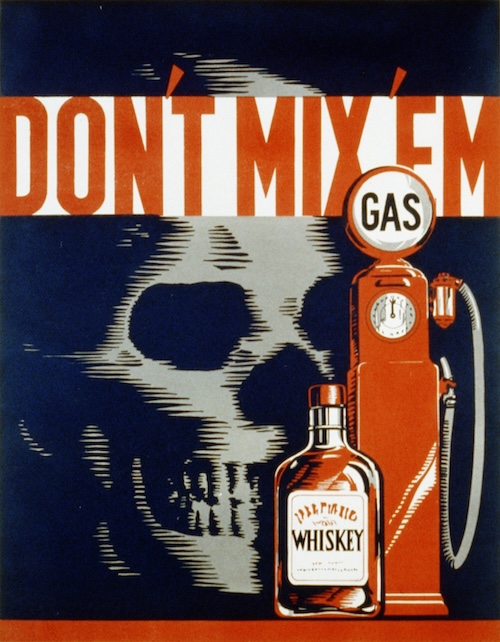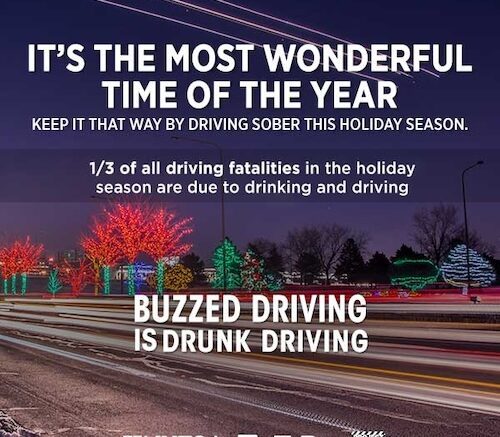By Greg Zyla 00
As the 2024 holiday season begins, we again present our yearly columns on the dangers of impaired driving and lots of statistics. However, before delving into the statistics, I want to emphasize the importance of examining the condition of old tires on newly acquired collector cars and the inherent risks associated with relying on them. To explain, we caught up with “Tire Choice Auto Service Centers” store manager Joe Jennings, who explained the risk during a recent visit to the Sayre, Pa. location.
Said Jennings, “There are many new owners who buy muscle cars from the 1960s and 1970s but don’t give serious attention to the tires, which are probably many years old yet still look good. These owners are so excited about their muscle car purchase they overlook the tires. Sure, they might make a successful straight-line full-throttle run on tires that are 25 years old, but they might not make it at high speed no matter how good they look. And, if you try to take turns at higher speeds, the percentage of tire failure increases dramatically.”
Jennings explained that tires on classic cars can decay from the inside while appearing perfect on the outside. This condition, known as dry rot, occurs when the rubber compounds in the tire break down over time due to factors like age, exposure to UV light, and lack of use. It’s always a good idea to consult with tire experts to help find the best tire for your specific vehicle. Regular inspections and proper storage can also help prevent dry rot and extend the life of your tires. (Tire Choice is owned by Monro, Inc.)
Now, onto our statistics and our yearly “Saga of young Joe.”
Drunk driving remains a significant issue, with about 37 people in the United States dying each day in drunk-driving crashes. This translates to one death every 39 minutes. In 2022, the latest official number from the NHTSA, there were 13,524 people killed in alcohol-impaired driving traffic deaths. Despite efforts to curb this, DUI-related fatalities have not seen a substantial decline.
According to stats I’ve researched in the last few years, accidents involving alcohol, and marijuana / drugs increased by approximately 25-percent estimated. Alarming are the DUI fatalities, whereas even with full-year 2024 stats not yet available, it looks like driver fatalities are still very troublesome. Thanks to the National Highway Traffic Safety Administration (NHTSA), here are some stats on drinking and driving.
 Over a 10-year period, more than 10,000 people die each year in drunk driving car accidents. On a good note, three years ago drunk driving deaths in the United States reached their lowest level (10,142) since 1982, which is the year the NHTSA began collecting data on drunk driving fatalities.
Over a 10-year period, more than 10,000 people die each year in drunk driving car accidents. On a good note, three years ago drunk driving deaths in the United States reached their lowest level (10,142) since 1982, which is the year the NHTSA began collecting data on drunk driving fatalities.
Also, according to NHTSA, drunk drivers face jail time when they’re caught, and the budgetary impact can be overwhelming. On average, a DUI can set you back $10,000 in attorney’s fees, fines, court costs, lost time at work, higher insurance rates, car towing, and more. And, drinking and driving can result in losing your driver’s license.
The yearly cost of alcohol-related car crashes is over $44 billion, according to the Centers for Disease Control and Prevention (CDC).
Alcohol-impaired drivers got behind the wheel of a car about 147 million times a year, according to the CDC. This is perhaps the most troublesome number of all.
According to NHTSA, five years ago, 32% of all drivers involved in fatal crashes while driving at night were drunk. Furthermore, almost twice as many alcohol-related fatal car crashes occur during the weekend.
Based on averages, there are four male alcohol-impaired drivers for every female alcohol-impaired driver on the road, says NHTSA.
NHTSA reported that four years ago, 50,930 drivers were involved in fatal car crashes, with an estimated 19% of the drivers being impaired by alcohol.
As we continue through these holiday weeks, we always present our “Saga of young Joe,” the fun-loving 26-year-old who is full of life, has many friends, and is a good person. He enjoys driving his 1969 Olds 442 W32, with its powerful V8 under the hood and unique under the front bumper W32 ram air setup. Since Joe lives in a warm climate state, taking his beauty out during the Christmas holiday is routine.
Joe could be your son, sibling, parent, friend, co-worker, or husband. He is having a wonderful time at a family dinner and quickly volunteers to make a run to the supermarket for needed refreshments. Even though he’s had one too many beers, he feels capable of driving his beautiful Olds 442 and sets off quickly on his way. It’s only 8 p.m. Fortunately, he’s alone.
Joe is oblivious that on this night he’ll become one of the estimated 37,000 drivers who will die in car accidents in 2024. He’s unaware he’s going 65-mph and approaching a curve that should be taken at 35-mph.
His reactions have been impaired by his alcohol consumption, and to make matters worse, his cell phone starts ringing. Joe is now completely distracted, and he’s going too fast to navigate the curve. Additionally, he forgot to buckle his seatbelt when he left his mom’s house, and before Joe even knew it, his 442 is off the road and headed directly toward a large tree.
There is no correction.
Joe’s 442 W32 hits the tree head-on with a resounding and loud metal crunch.
At 1/10th of a second, the car’s front bumper and grille work collapse.
At 2/10ths of a second, the hood crumbles, rises, and smashes into the windshield. The grille work now disintegrates.
At 3/10ths of a second, Joe is sprung upright from his seat. His legs are immediately broken, and his knees crash against the dashboard. The steering wheel bends under his grip.
At 4/10ths of a second, the front of the Olds 442 is destroyed and is now completely still. However, the rear end of the car is still traveling at 55-mph, and the 600-pound V8 engine and accessories are crunched further into the tree.
At 5/10ths of a second, the impact rips Joe’s sneakers clean off his feet. The Oldsmobile’s chassis bends in the middle, and Joe’s head is slammed into the windshield. The car’s rear end begins its downward fall as the spinning wheels churn into the ground.
At 6/10ths of a second, the entire body of the 442 W32 is twisted out of shape while the front bucket seat continues to ram forward.
At 7/10ths of a second, Joe’s chest is pinned against the steering wheel shaft while his internal organs crash against his rib cage.
At 8/10ths of a second, Joe is dead.
He’s just become another fatal accident statistic.
The lesson to learn from Joe’s tragic ending? More than 25-percent of all traffic-related deaths are the direct result of alcohol impairment. Further, approximately 800 people are injured per day in drunk driving crashes (NHTSA).
Therefore, if you plan to drive after having a few beers or two shots of whiskey, be fully aware of the dire consequences. Most of my readers know older muscle cars are not known for doing well in any type of impact, nor do they handle very well. They just don’t offer the high-end safety equipment that is now common in our modern vehicles and make sure you check those older tires.
Next week, we will examine impaired driving statistics, focusing specifically on cell phone usage and texting while driving. Remember it’s not just the young drivers at fault here as middle-aged to baby-boomers are DUI statistics, too. They are all dangerous on our highways.
Special thanks to Tire Choice’s Joe Jennings, NHTSA, CDC, AAA, and Mecum Auctions for the 442 W32 photo. (Less than 300 1969 442 W32 Ram Airs were ever built.)
(Greg Zyla is a syndicated auto columnist. He welcomes reader questions and comments on collector cars, auto nostalgia or motorsports at extramile_2000@yahoo.com or at 303 Roosevelt St., Sayre, Pa. 18840.)



Be the first to comment on "Cars We Remember / Collector Car Corner; The continuing Saga of Young Joe, DUI statistics, and tire recommendations"